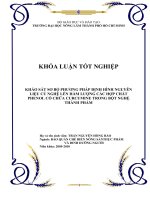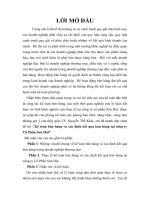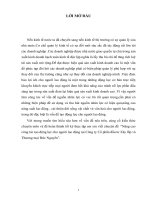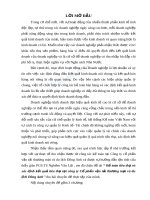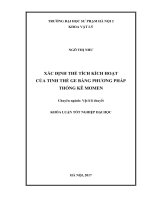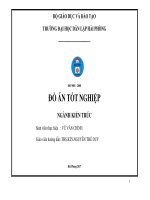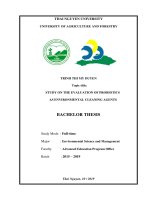Luận văn tốt nghiệp GRADUATION THESIS: THE IMPLEMENTATION OF CUSTOMS PROCEDURES FOR IMPORTED MEDICAL EQUIPMENT GOODS AT POZITRONICS CO., LTD.
Bạn đang xem bản rút gọn của tài liệu. Xem và tải ngay bản đầy đủ của tài liệu tại đây (677.34 KB, 93 trang )
MINISTRY OF FINANCE ACADEMY OF FINANCE
Faculty of Taxation and Customs
----------
GRADUATION THESIS
TOPIC:
THE IMPLEMENTATION OF CUSTOMS PROCEDURES FOR
IMPORTED MEDICAL EQUIPMENT GOODS AT POZITRONICS CO.,
LTD.
Speciality: Customs and Foreign Trade Operations
Code:
05
Instructor: PhD. Vu Duy Nguyen
HANOI - 2020
Graduation
Thesis
Academy of
Finance
DECLARATION
I hereby declare that this thesis is a report of my own research and effort
and all the data, information provided in this thesis are true and based on reality.
Hanoi, May.........................................................................................................2020
Student
i
Graduation
Thesis
Academy of
Finance
TABLE OF CONTENTS
DECLARATION......................................................................................................i
TABLE OF CONTENTS........................................................................................ii
ACKNOWLEDGEMENTS
................................................................................................................................
vi
LIST OF ACRONYMS
...............................................................................................................................
vii
LIST OF TABLES
..............................................................................................................................
viii
LIST OF FIGURES
................................................................................................................................
ix
INTRODUCTION...................................................................................................1
CHAPTER 1............................................................................................................5
THEORETICAL BASIS FOR CUSTOMS PROCEDURES FOR MEDICAL
EQUIPMENT IMPORTS............................................................................................5
1.1. Overview of medical equipment imports.................................................................5
1.1.1. Definition of medical equipment imports................................................................5
1.1.2. Classification of medical equipment article.............................................................9
1.1.3. Role of medical equipment imports
10
1.2. Customs procedures for medical equipment imports at enterprises
11
1.2.1. Indentification of HS code, customs value and tax rate
11
ii
Graduation
Thesis
Academy of
Finance
1.2.2. Checking commodity documents
12
1.2.3. Registration of specialize import license
14
1.2.4. Customs declaration and customs declaration form transmission
16
1.2.5. Taking of delivery order
17
1.2.6. Preparation of customs document set
18
1.2.7. Tax payment and goods import customs procedure finalization
20
1.2.8.
Implementation of procedure of exchange for the delivery order
and transportation of goods to the warehouse
21
1.2.9. Import customs procedure solving time-limit
22
1.2.10.
Preparation of documents and goods for inspection after customs
clearance (if any)
23
1.3.
Factors affecting the customs clearance of medical equipment imports
at enterprises
24
1.3.1. Subjective factors
24
1.3.2. Objective factors
25
iii
Graduation
Thesis
Academy of
Finance
CHAPTER 2
................................................................................................................................
27
SITUATION OF IMPLEMENTING CUSTOMS PROCEDURES FOR
MEDICAL EQUIPMENT IMPORTS AT POZITRONICS CO., LTD
................................................................................................................................
27
2.1
Overview of development situation of Pozitronics Co., Ltd
27
2.1.1. Development and establishment history
27
2.1.2. Functions, tasks
28
2.1.3. Organizational machinery
29
2.1.4. Operation situation of Pozitronics Co., Ltd.
30
2.2
Legal bases associated with the customs clearance process for medical
equipment imports at Pozitronics Co., Ltd
34
2.2.1. Customs Law 2014
34
2.2.2. Foreign Trade Management Law 2017
35
2.2.3.
Decree No. 03/2020/ND-CP amending Article 68 of Decree No.
36/2016/ND-CP as amended and supplemented in Decree No. 169/2018/NĐ-CP
with regard to medical equipment management
36
iv
Graduation
Thesis
2.2.4.
Academy of
Finance
Decree No.74/2018/ND-CP amending and supplementing some
articles of Decree No. 132/2008/ND-CP regulating specifically the enforcement
of some articles of the law on quality of products and goods 42
2.2.5. Circular 30/2015/TT-BYT
46
2.2.6. Circular No. 14/2018/TT-BYT
48
2.2.7. Circular No. 39/2016/TT-BYT
49
2.3.
Situation of implementing custom procedures for medical equipment
imports at Pozitronics Co., Ltd
50
2.3.1.
Situation of import of medical equipment articles at Pozitronics Co.,
Ltd
50
2.3.2.
Process of implementing customs procedures for medical equipment
imports at Pozitronics Co., Ltd
52
2.4.
Evaluation of the status of implementation of customs procedures for
medical equipment imports at Pozitronics Co., Ltd
60
CHAPTER 3
................................................................................................................................
65
ORIENTATIONS OF AND SOLUTIONS TO IMPROVE THE EFFICIENCY
OF IMPLEMENTING CUSTOMS PROCEDURES FOR MEDICAL
EQUIPMENT IMPORTS AT POZITRONICS CO., LTD.
................................................................................................................................
65
v
Graduation
Thesis
Academy of
Finance
3.1. Development orientations of Pozitronics Co., Ltd.
65
3.1.1. General development orientations
65
3.1.2. Future goals of the company for medical equipment imports
66
3.2.
Solutions to strengthen the implementation of customs procedures for
medical equipment imports at Pozitronics Co., Ltd
67
3.2.1. Solutions related to technical customs contents
67
3.2.2. Improving qualification, effectively training human resources
70
3.2.3. Completion of documents related to import customs procedures
71
3.2.4. Upgrade of material facilities and technologies
71
3.2.5.
Update of information and regulations on the customs laws;
completion of legal bases
72
3.2.6.
Joining in associations, partnerships and management agencies in
the joint implementation of import customs procedures
73
3.3. Recommendations towards the company
73
REFERENCES
................................................................................................................................
77
vi
ACKNOWLEDGEMENTS
First of all, I truly appreciate the internship opportunity at Pozitronics Co.,
Ltd. They gave me a chance to corporate at work and to gain more not only
knowledge but also experience.
Besides, I would like to express my profound gratitude to my supervisor
Mr. Vu Duy Nguyen - Deputy of Tax & Customs Department - who has
continuously helped and encouraged me to develop the understanding of the
subject. I could not complete my graduation thesis without his enthusiastic
instructions, advice and correction.
LIST OF ACRONYMS
B/L
:
Bill of Lading
CFS
:
Container Freight Station Fee
CT
:
Computed Tomography
DO
:
Delivery Order
EIR
:
Equipment Interchange Receipt
IVD
:
In vitro diagnostic medical device
L/C
:
Letter of Credit
MRI
:
Magnetic Resonance Imaging
THC
:
Terminal Handling Charge
VAT
:
Value Added Tax
LIST OF TABLES
Table 1.1. Classification of medical equipment by groups......................................9
Table 2.1. Income statement of Pozitronics Co., Ltd. (2017 – 2019)
................................................................................................................................
30
Table 2.2. Quantity of medical equipment import declarations in the period of
2017 – 2019
................................................................................................................................
50
LIST OF FIGURES
Figure 1. Organization chart of Pozitronics Co., Ltd
................................................................................................................................
30
Figure 2. Comparison of number of business import declarations of Pozitronics
Co., Ltd. in the period of 2017-2019
................................................................................................................................
51
Graduation
Thesis
Academy of
Finance
INTRODUCTION
1.
Necessity of the study
In the present trend of globalization and internationalization, foreign
economic activities in general and import-export activities in particular are
becoming more urgent than ever. It plays a very important role in the process of
socio-economic development in Vietnam and the world as well. The fact shows
that import and export business activities in Vietnam have been gradually
growing. Enterprises operating in the field of import and export are still
expanding in both scale and stature, which have contributed to speed up the
growth of the Vietnamese economy, helping the Vietnamese economy
participate in integrating and expanding international trade relations with other
advanced countries in the world.
In the field of import and export business, the customs clearance process
is an extremely-important and relatively-complicated process. The customs
clearance process asks the enterprises operating in the field of import and export
to possess deeply-experienced staff, master specialized operations and have
knowledge of the laws. Therefore, if the enterprises want to complete an importexport business process well, they should follow the customs clearance
procedures well. To sum up, building a reasonable process and applying the
process correctly and flexibly based on the input standards will bring about great
values at the output stage of the process; these values will become much more
effective if they are considered the inputs of another process. On the contrary,
any failure to control and operate the process properly will cause serious
consequences to the overall operation of processes in enterprises and
organizations.
Currently, our country has limited human resources, equipment and
production knowledge, which have not been fully exploited, resulting in the fact
that many types of modern equipment have not been put into production or they
11
Graduation
Thesis
Academy of
Finance
have been put into production but not worked efficiently. Therefore, domestic
enterprises have always given priority to speeding up activities of importing
modern machinery and equipment to meet essential needs of the State and
people. To facilitate the import of goods for business purposes, the enterprises
should fully implement import customs procedures and receive permits by the
relevant ministries and branches for the essential goods.
The foregoing issues made me realize how important the customs
clearance process for imports for business purposes is. Therefore, during my
internship at Pozitronics Co., Ltd., with the learnt knowledge together with the
enthusiastic help of PhD. Vu Duy Nguyen and the teachers of the Department of
Taxation – Customs as well as the staff currently working for Pozitronics Co.,
Ltd., I have bravely learnt about, studied and selected the thesis “The
implementation of customs procedures for imported medical equipment goods
at Pozitronics Co., Ltd” as my course-end thesis.
2.
Thesis study purpose
Having an opportunity to survey and learn about the import business
activities and thus drawing lessons for the author herself.
Comparing, analyzing and evaluating theoretical knowledge versus
practical knowledge, and implementing the motto “Study goes as a pair with
practice”.
Researching the theory and the status of implementation of customs
procedures for medical equipment imports at Pozitronics Co., Ltd.,and thereby
analyzing, evaluating and proposing solutions to enhance the implementation of
customs procedures at the Company.
3.
Study subject and scope
Study subject: Carrying out the customs procedure process for medical
equipment imports at Pozitronics Co., Ltd.
12
Graduation
Thesis
Academy of
Finance
Study scope: Carrying out customs procedures for medical equipment
imports at Pozitronics Co., Ltd.
Period scope: 2017 – 2019 period.
4.
Study method
During theresearch, many different methods have been applied in the
thesis. They are dialectical materialism method, systematization method,
comparative statistical method, qualitative analysis method, synthesis, logical
reasoning,
etc.,
thereby
conducting
research,surveying
the
status
of
implementation of customs clearance process for medical equipment imports at
Pozitronics Co., Ltd.
The SWOT matrix method is used to analyze strong points, weak points,
opportunities and threatens in the implementation of customs procedures for
medical equipment imports at Pozitronics Co., Ltd.
5.
Thesis’s structure
Apart from the foreword and conclusion parts, the thesis is composed of
three chapters as follows:
Chapter 1: Theoretical basis for customs procedures for
the medical equipment imports.
Chapter
2:
Situation
of
implementing
customs
procedures for medical equipment imports at Pozitronics Co., Ltd.
Chapter 3: Orientations of and solutions to strengthening
the implementation of customs procedures for medical equipment imports at
Pozitronics Co., Ltd.
Due to limited practical theoretical knowledge, shortcomings in the
contents and research method of this thesis may be unavoidable. I strongly hope
to receive suggestions and advices from the teachers and the staff of Pozitronics
Co., Ltd.
13
Graduation
Thesis
Academy of
Finance
Finally, I would like to express my sincere thanks to PhD. Vu Duy
Nguyen and staff of Pozitronics Co., Ltd. for their whole-hearted help to me in
order to complete this thesis.
CHAPTER 1
THEORETICAL BASIS FOR CUSTOMS PROCEDURES FOR
MEDICAL EQUIPMENT IMPORTS
1.1.
Overview of medical equipment imports
1.1.1. Definition of medical equipment imports
Imports are subjects to be cleared and subject to inspection and
supervision by the customs authorities.
Imports1are the goods which are brought into the territory of Vietnam
from abroad or from separate customs areas in accordance with laws.
Based on the import purposes, imports are classified into two main
groups:
Firstly, imports for non-business purposes are also referred to as noncommercial imports or formerly referred to as non- commercial imports. Imports
for non-business purposes are the goods which are brought into the Vietnamese
customs territory or special areas within the Vietnamese territory which are
considered as separate customs areas according to the laws for non-profit
purposes (not for profitability purposes) but mainly for purposes of support,
charity, mutual affection or for the living and consumption needs of
organizations and individuals. In other words, imports for non-commercial
purposes are the goods which are brought into the customs territory but not
associated with the business activities of merchants.
1
Section 1.1.1, Part 1.1, Chapter 1, Textbook “Customs inspection and supervision”.
14
Imports for non-commercial purposes include:
Gifts and presents of overseas organizations and individuals delivered to the
Vietnamese organizations and individuals;
Movable assets of organizations and individuals;
Personal luggage of passengers on entry;
Goods of diplomatic representative agencies and international organizations in
Vietnam and people working at these agencies and organizations;
Humanitarian aid goods;
Free sample goods;
Temporarily imported working tools and means of agencies, organizations and
people on termed entry;
Etc…
Secondly, business imports are also referred to as commercial imports or
formerly referred to as trade imports. Business imports are the goods imported
for the purpose of seeking profits. In other words, business imports are the
goods brought into the Vietnamese customs territory for the purposes of
business or commercial activities of merchants.
Commercial activities of merchants include: goods purchase and sale;
commercial service supply; investment; trade promotion and other commercial
activities for the profitability purpose.
For the approach that business imports are the goods brought into the customs
territory for the purpose of commercial activities of merchants,business imports
consist of many different categories
corresponding to specific commercial activities/behaviors, which are:
Imports under sale and purchase contracts;
Imports for commercial service supply activities such as goods processing,
transit, transshipment, etc.;
Imports for investment activities;
Imports for trade promotion activities such as attending fairs, exhibitions, sales
presentation, advertisement, promotion, ...;
Imports for other commercial activities.
For the approach in a narrow sense, business imports are merely the goods
imported under goods sale and purchase contracts.
With this approach, business imports include:
Imports for business;
Temporarily-imported and re-exported business goods;
Business goods transferred from border gate to border gate;
Goods which are raw materials and supplies imported to produce exports;
Imported business goods of border residents;
Etc…
Each type of those imports has different properties and characteristics, so the
customs procedures and customs inspection and supervision regime also have
different points.
Medical equipment 2is devices, instruments, materials, implants, reagents,
in vitro calibratorsand softwares that are used individually or in combination
with each other as designated by medical equipment owners for human use for
one or more of the following purposes:
Diagnosing, preventing, monitoring, treating and mitigating medicals or
compensating for injuries or traumas;
Carrying out tests, replacements and adjustments; assisting in operations and
physiological processes;
Supporting or sustaining life;
Controlling conception;
Sterilizing medical equipment, including chemicals used in the tests;
Being used for specialized transportation or medical activities;
Providing information for diagnosis, monitoring and treatment through
inspection of specimens originating from the human body.
A medical device is any device intended to be used for medical purposes.
Thus what differentiates a medical device from an everyday device is its
intended use. Medical devices benefit patients by helping health care providers
diagnose and treat patients and helping patients overcome sickness or disease,
improving their quality of life. Significant potential for hazards are inherent
when using a device for medical purposes and thus medical devices must be
proved safe and effective with reasonable assurance before regulating
governments allow marketing of the device in their country. As a general rule,
as the associated risk of the device increases the amount of testing required to
2
Clause 1, Article 2, Decree No. 36/2016/ND-CP
establish safety and efficacy also increases. Further, as associated risk increases
the potential benefit to the patient must also increase.
1.1.2. Classification of medical equipment article
Medical equipment consists of 2 groups, which are divided into 4
categories based on the potential risk level related to the technical design and
manufacture of such medical equipment3.
Table 1.1. Classification of medical equipment by groups
Group
Category
Risk level
Example
1
A
Low
Tongue depressor,
retractor
B
Medium – Low
Needle, suction
apparatus
C
Medium – High
Respirator, bone
hold-down plate
Cardiac value, cardiac
vibration
2
transplanted in the
D
High
(Source: Clause 3, Article 1, Decree No. 169/2018/ND-CP)
3
eliminator
Circular No. 39/2016/TT-BYT
body
- Accordingly:
Classification of medical devices other than in vitro diagnosis devices (NonIVDMD): 16 rules.
Classification of in vitro diagnosis medical devices (IVDMD): 7 rules.
In case a medical device can be classified into two or more risk levels, the
classification according to the highest risk level of such medical device shall
apply.
In case a medical device is designed to be used in combination with
another medical device, the separate risk level classification must be done for
each medical device.
In case a medical device is used in combination with another medical
device or a medical device has two or more use purposes, the classification must
be based on the most important use purpose of such medical device.
1.1.3. Role of medical equipment imports
Medical equipment is a special commodity directly affecting human
health, which is one of the important factors deciding on the effectiveness and
quality of health care and assisting physicians in diagnosing and treating patients
accurately, quickly, safely and effectively.
Currently, 90% of medical equipment in Vietnam is imported. Among
them, 30% of the total import value of medical equipment is diagnostic imaging
devices including MRI magnetic resonance devices, CT scanners, ultrasound
and X-ray devices. This helps to reduce the shortage of modern equipment in
health establishment due to the growing population (from 2019 to 2029).
In addition, medical equipment imports promote the development of the
infrastructure of the health sector, mobilize investment worth thousands of
billion Vietnamese Dong in medical equipment, encourage the development of
the private health sector, and strengthen satellite hospital routes.
